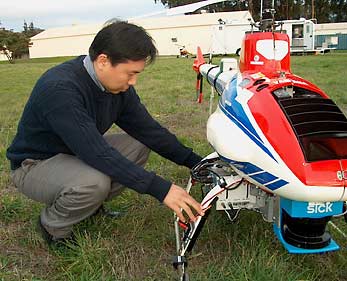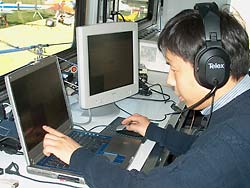UC Berkeley Press Release
 An autonomous helicopter completes its run through an "urban canyon" at the UC Richmond Field Station. Walking below is Travis Pynn, a member of the Berkeley Aerial Robot (BEAR) group and one of the safety pilots on standby to take over control of the helicopter if needed. (UC Berkeley photos) |
UC Berkeley researchers field testing low-altitude robo-copters
BERKELEY – When scale model helicopters pass through a makeshift "urban canyon" in a test field, or engage in a game of aerial "chicken", the drills may look like a robotic stunt show to outside eyes. But behind the exercises lie significant technical breakthroughs by researchers at the University of California, Berkeley.
 David Hyunchul Shim, a research engineer with the BEAR group, inspects an autonomous helicopter before a field demonstration. |
Members of the university's Berkeley Aerial Robot (BEAR) program have successfully conducted a series of field tests with 130-pound helicopters that not only fly autonomously -- without human control -- but that also react to avoid obstacles in their flight path.
"Our BEAR group is the first to successfully develop a system where autonomous helicopters can detect obstacles, stationary or moving, and recompute their course in real-time to reach the original target destination," said David Hyunchul Shim, a research engineer on the project who first began this work as a UC Berkeley Ph.D. student in mechanical engineering.
With these achievements, the researchers are inching towards a future of robo-copters that could maneuver through city streets or forested landscapes.
The development of reliable systems that can handle obstacle-avoidance tasks is still several years away, researchers said, but the computational foundations for such unmanned aerial vehicles (UAVs) have been laid.
The BEAR group's work on autonomous helicopters began in 1996 with support from the U.S. Army Research Office and the Office of Naval Research, and it continues today. Additional support comes from the Defense Advanced Research Projects Agency (DARPA) Software Enabled Control program and industrial collaborators.
In 2003, DARPA began funding specific research on obstacle avoidance as part of the agency's Unmanned Combat Armed Rotorcraft (UCAR) program, which aims to integrate autonomous helicopters in combat and reconnaissance missions. This research into avoiding unknown obstacles, a field called nonlinear model predictive control (MPC), is one of several UAV projects in the BEAR group.
 Travis Pynn of the BEAR group examines the inner workings of a helicopter before a field test. |
The MPC collision avoidance technology, when coupled with a sensor, would be applicable to a wide range of both manned and unmanned helicopters, the researchers said. They noted that the development of autonomous collision avoidance capabilities for aircraft could significantly reduce accidents and save lives.
The UC Berkeley researchers also see significant potential for civilian applications, such as for automated search and rescue missions, inspections of power lines and pipelines or fighting wildfires. The helicopters could also be used to carry thermal imaging equipment used in agriculture to detect pest infestations.
"Autonomous helicopters would be ideal in many situations where it would be too dangerous for humans to go," said S. Shankar Sastry, UC Berkeley professor of electrical engineering and computer sciences and lead faculty member of the BEAR program.
In one of the recent field demonstrations, UC Berkeley researchers pre-programmed a helicopter flight path that passed through 10-foot-tall canopy tents set up in a two-by-three grid as a mock "urban canyon." In one scenario, the presence of the tents was included in the flight path, but the helicopter's computer system was responsible for figuring out how to avoid them.
In a more challenging test, the tent locations were not included in the flight path, so the helicopter's laser scanner, which provides a three-dimensional image, had to first detect the obstacles and adjust its course so as not to hit the tents.
The researchers noted that the helicopters stayed impressively true to the calculated flight paths, never veering more than 12-inches off course.
"In the real world, the problem with pre-loading a set flight path in an aircraft's computer, the basis for autopilot programs, is that information at low altitude changes," said Sastry. "The map or geographical information you're using could be outdated because a new building may have been erected or some other change occurred. We are developing a system that can react to those changes without human intervention."
UAVs are currently limited to altitudes where the chances of the aircraft running into a building, tree or even another aircraft are small to nonexistent. Unmanned rotorcraft are particularly attractive because of their greater maneuverability over their fixed-wing counterparts. Helicopters can hover and are capable of vertical takeoffs and landings, so they can be used in relatively dense areas.
"Fixed-wing UAVs can tolerate less precision in control algorithms because they can glide for a time if something goes wrong," said Sastry. "In contrast, helicopters are inherently unstable, so the control inputs need to be exact, and they need to come quickly to keep the helicopter from falling from the sky."
In addition to the "urban canyon" exercise, the researchers have successfully tested two helicopters flying towards each other in a game of aerial chicken. The test demonstrated the ability of the autonomous helicopters to interact with each other. During the flight, the helicopters regularly transmitted signals to a ground station computer indicating their locations. The ground station computer sent back information alerting the helicopters to each other's presence. The helicopters then adjusted their respective courses to fly around each other, avoiding a mid-air collision, all without human intervention.
"To our knowledge, we are the first to successfully test fly multiple autonomous helicopters interacting with each other," said Hoam Chung, UC Berkeley graduate student in mechanical engineering and a member of the BEAR group.
 David Hyunchul Shim monitors an autonomous helicopter in flight at a recent demonstration at the UC Richmond Field Station. |
For the project, the BEAR team adapted four radio-controlled, gas-powered helicopters, each weighing approximately 130 to 160 pounds and measuring 12 feet long. The helicopters are built commercially in Japan, primarily for use as crop dusters. The UC Berkeley researchers equipped the rotorcraft with a variety of off-the-shelf technology specifically customized for autonomous UAVs.
For instance, the helicopters each carry two industry-grade onboard computers running on a QNX operating system designed for real-time computation. The researchers adapted inertial navigation and global positioning systems to help stabilize the helicopters during autonomous flight, and they installed wireless modems and Ethernet systems for data communication.
To survey the terrain ahead, the helicopters utilize laser scanners, including one designed to repeatedly tilt up and down to create a three-dimensional image. The researchers have also made strides in the use of computer vision for flight and landing exercises as part of a separate contract with Boeing.
Advances in battery technology have enabled the UC Berkeley researchers to also develop and successfully demonstrate the first electric autonomous rotorcraft. The electric helicopter is powered by lithium-polymer batteries -- the same type of batteries used to power modern cell phones -- and is about half the length of the gas-powered rotorcraft used by the BEAR group for obstacle-avoidance research.
"Batteries are providing more energy with less weight than ever before," said Shim. "Electric helicopters were no more than expensive toys just five years ago, but now they fly better and longer
than comparable gas-powered rotorcraft with much less noise and absolutely no pollution. Electric helicopters are still smaller than gas-powered ones, but they will catch up with advances in battery technology."
Shim added that electric helicopters could potentially be used for extended missions because they can be routinely recharged at solar energy stations without human assistance. Electric motors have the additional benefit of being able to start and stop automatically, while humans are often needed to help "pull start" a gas-powered engine.
The researchers have fully tested autonomous takeoff and landing with the electric helicopter. They have also tested fully autonomous landings and semi-autonomous takeoffs for the gas-powered rotorcraft.
During all field tests, the human pilots are on standby to take over if the helicopters' autonomous systems fail. Other members of the BEAR group include Peter Ray, the laboratory manager, and pilots Travis Pynn and Perry Kavros.
The BEAR group is planning to continue more field tests in 2005.

